Should you get a pet for a child with allergies? What are some things to consider?
I can now laugh a little about our journey discovering our son’s allergies to cats and dogs. Some challenging allergy issues arose, and we had to make decisions, even on how to reduce the allergic reactions.
I had a cat before I got married and had a child. The cat came with me into our marriage and into parenthood. When I was pregnant and my belly was big, my cat would sit on my belly. The baby did not like anything touching him. The cat would sit on my belly, and the baby would start kicking. The cat would be bouncing up and down, looking around the room, trying to figure out what was going on! When my son was born, the cat was not very happy about him. She never touched him or hissed at him. She would just sniff the baby carrier and look at us like, “You brought it home again?!?” Then, she would walk away. She has provided much humor for our family.
The Allergies
When our son was very young we realized he had a lot of food and environmental allergies and contact allergies. When he was 2 years old, the allergist tested him by skin prick (sometimes called a puncture or scratch test) for allergic reactions to cats and dogs. This type of testing measures the presence of IgE antibodies for the suspected allergen. Our skin prick test result for dog was negative, a “0”, and the result for cat was a “2”, very low, not considered a true allergy by that allergy clinic. The allergist said to not let the cat sleep with our son or be in his face. That was easy because the cat never got that close to him. Remember, she couldn’t believe we even brought the kid home. So, we didn’t really worry about allergic reactions to cats and dogs.
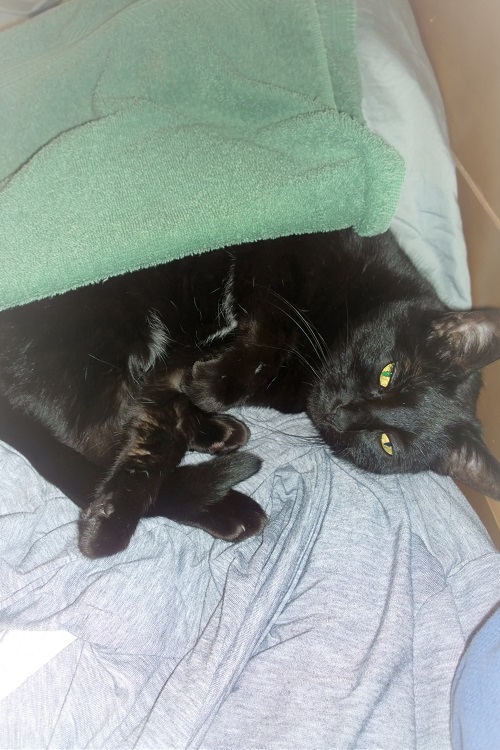
Cat relaxing on the clean laundry
The Cat
As my son got older, our cat would check on him at night. She really became protective of him in a distant sort of way. After he was asleep, she would carefully jump on his bed and walk around him. Then, she would go somewhere else to sleep for the night. We never noticed any type of allergic reaction in our son regarding the cat. She was never very close to him. One day, we were visiting family members who had a few indoor cats. Our son was petting one of their friendly cats, and they were becoming good buddies. Within a few minutes, my son came to me his face pink and his eyes were bloodshot. He told me his eyes were burning badly. We went to the bathroom to rinse his face with cool water. He told me the cat had licked him on his forehead. I pulled his hair away from his face and there was a hive about the size of a cat’s tongue on his forehead. We treated the allergic reaction, and he recovered just fine.
After that cat allergy incident, I asked the Naturopathic Doctor we were seeing to test him for an allergy to specific cats. Our ND uses the NAET method, which is the Nambudripad’s Allergy Elimination Technique. She tested him for several different cats and discovered he was allergic to cats and it seemed the saliva was the worst allergy. We spent a few months using the NAET method to eliminate my son’s allergy to the cats he was in contact with the most. He is now able to go to his friends’ houses and be around their cats without any allergic reactions. Cats were solved now!
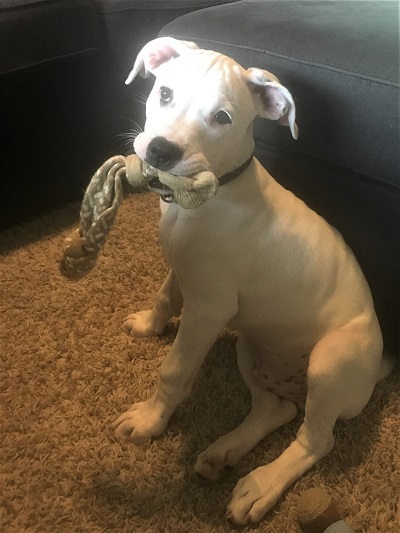
The Dog
Now for the dog learning curve. When our son was born, we did not have a dog. A few years ago, I started thinking it would be great to get our son a dog. A boy and his dog! I imagined all of the bonding, fun, games, and protection that would come with a dog. Since dogs were a “0” on the allergy test, I did not imagine an allergy being a problem. (Insert laugh here.)
When our son was 5 years-old, he participated in a dog-reading program. Where children can sit with a dog and read books aloud. I thought this would be a great opportunity for our son to read aloud and to give him more time with dogs to help determine if he really wanted a pet dog. On our 3rd visit of reading time with the reading dog, the dog started licking my son. We didn’t think anything about until about 10 minutes later when my son’s hands and face were covered with hives. I immediately treated the allergic reaction. Then, I started asking about treats that the dog may have eaten, maybe something with peanut butter. The trainer said no treats with nuts. That was bizarre. First reaction with a dog, but not sure what the trigger really was.
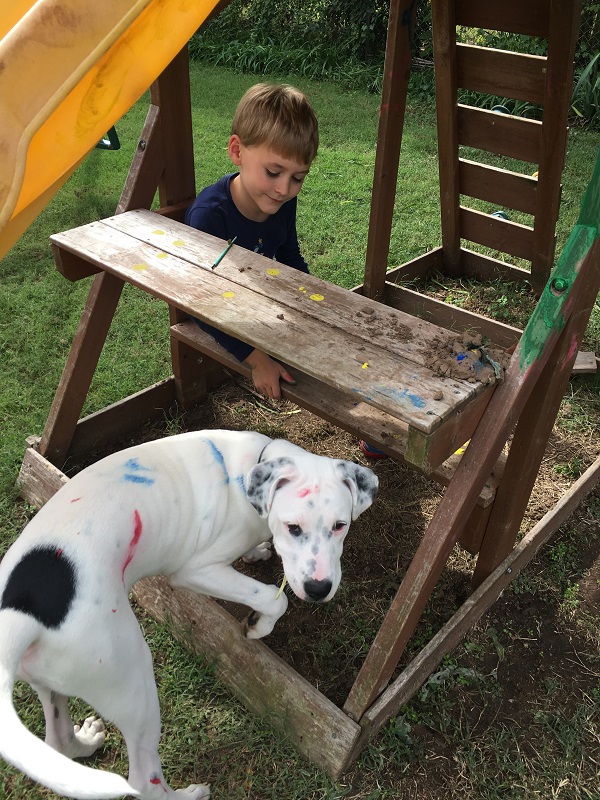
Several months later, a sweet little 5 week old abandoned puppy found us. He was adorable and tiny, just the perfect pet for our young son. We took him to a local veterinarian. The vet said he was healthy despite being so young, just needed to gain a little weight. So, we took the puppy home and surprised our son. He named the puppy Snowy because he was mostly white, and a forever bond began. Now, Snowy is part Pointer bird dog. Snowy has a great sniffer and likes to hunt the small woodland creatures that frequent our backyard. One of the creatures that were plentiful when Snowy joined our family was the squirrel. The squirrels liked to bury pecans in our yard. One of our son’s severe allergies is to nuts – pecans are a big trigger. So, the squirrels would bury the pecans, the dog would chase the squirrels sometimes disrupting the burying plan, sometimes he would dig up the pecans and eat them. UGH! Then, he would come and lick the boy-child’s face. Hives would appear all over the child’s face. I thought it was because the dog had chewed on pecans then licked the child, but I had my suspicions at this point – reading dog buddy, new puppy pet…hmmmm.
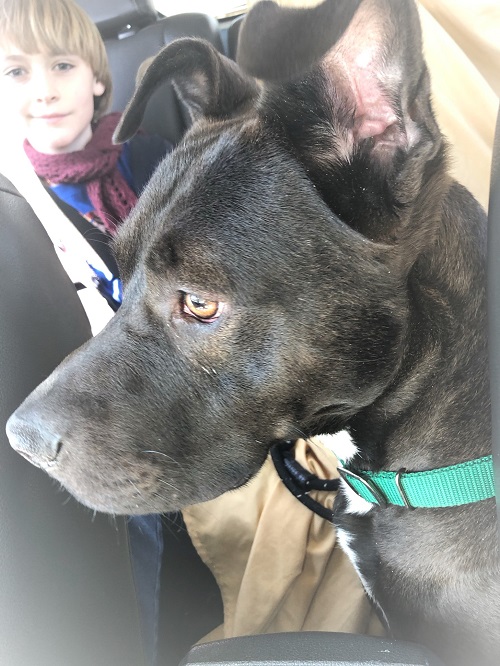
We returned to our Naturopathic Doctor to test for sensitivities to dogs, specifically this new “best friend.” The ND confirmed that our son was allergic to his dog, his best friend, his first pet. (There were some tears shed. My great dog idea was not going well.) So, we began the NAET treatments again, but this time for dogs, and specifically, our dog. Once again, the saliva was the biggest trigger. (No reaction with the reading dog until he started licking.) After a few treatments to eliminate the dog allergy, we were successful! Our son and his bestie, Snowy, were safe to be together now. A huge sigh of relief over that!!! And very grateful we were able to overcome that issue and move forward. It’s now been a few years, and Snowy has successfully driven the squirrels from our backyard. They run the fences, but rarely are they brave enough to come into our yard.
Since we had the allergy treatments for our dog, we had to return for more treatments for a friend’s dog. At that point, we decided to treat dogs on a broad spectrum, not just for our dog or our friend’s dog. We were getting smarter! This approach worked well for our son. He is able to be around other dogs now. It has worked so well, that we adopted another rescue dog. Our son is very happy with his dogs.
What are some things to consider if you have allergies and are thinking of adding pets to your home?
- Have you had an allergy test? Do you know if there are certain animal types to avoid? As we discovered, a conventional allergy test doesn’t always give you the exact information you will need, but they sometimes do, and can be helpful.
- Research allergy-friendly pets. Some dogs and cats are allergy-friendly. Are you allergic to dander, fur, or saliva? Or all of it?
- Can you spend time with different pets that belong to friends and family? This is helpful to know if a certain type of animal is problematic. I also recommend spending time with multiple animals because one animal may not cause a trigger, but another may.
- Do you know of a good, conservative NAET practitioner? We were fortunate we already had a great NAET practitioner, and this technique works great for our family.
- Is immunotherapy (allergy shots) an option for you? This option should be discussed with your allergy doctor to determine if it is right for you.
Pets can be positive benefits to their families
Pets can bring a lot of joy and comfort into your home. Even through the challenges, we have loved having our pets. They are a lot of work, but they bring more joy, laughter, love, and happiness than anything else.
We wish you the best of luck on your pet adventures! May you find your furever furbabies!
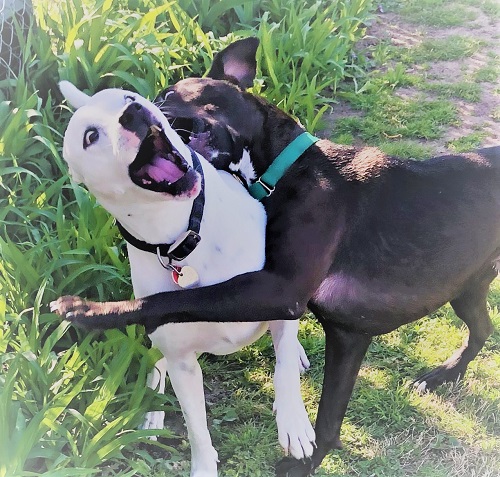

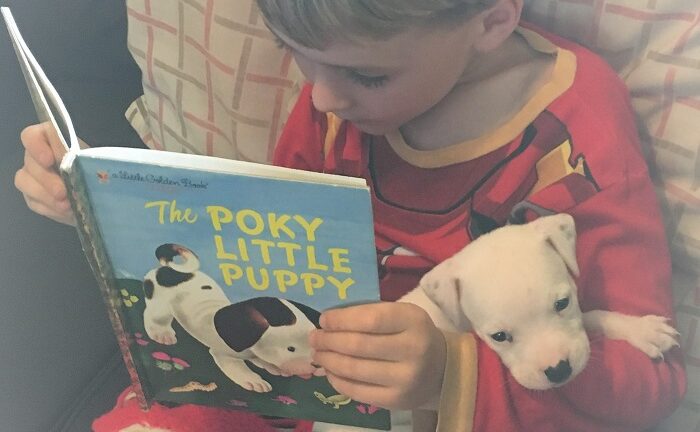

This is great information! We just got a sheepadoodle puppy hoping our family with allergies will be okay with him. Fingers crossed!
Oh how exciting! A new puppy. They are so much fun. I hope it is the best experience for your family!
Both my son & I are allergic to dogs & cats, so this has certainly been an interesting read! I’ve never head of that type of treatment before, I’m really glad it helped your son & am going to check into it. Thanks!
Thank you. If you have any questions, please let me know. 🙂
Charlie – THANK YOU! THANK YOU! THANK YOU!!! I am so glad you and your family went to such lengths to overcome your son’s allergies and be able to include pets in your home. As a veterinarian, I have countless stories of pets being pushed aside (kept outdoors or locked up in a crate, etc) and even surrendered as a result of a family dynamic such as this. Your story is a phenomenal account of how pets can enrich our lives and be included in our daily activities, despite circumstance that might dictate otherwise.
Thank you, Robin! We love our pets and couldn’t think of a day without them. I really appreciate your insight and kind words. My entire goal of sharing our journey is to help others.